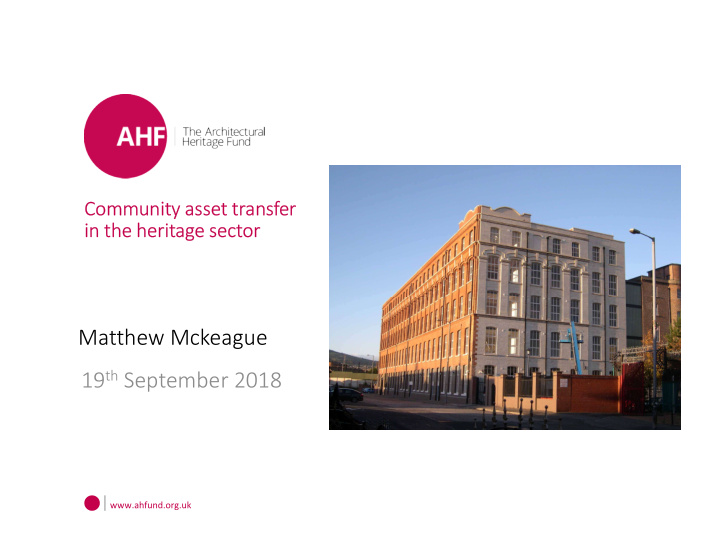



Community asset transfer in the heritage sector Matthew Mckeague 19 th September 2018 www.ahfund.org.uk
“Who owns and controls the places in which social capital is accumulated and formed? Whether bowling alleys, football clubs, churches or digital hangouts, these assets support the flow of social activity, care, fun and friendships. They are the ‘civic operating system’ that fosters togetherness and provides a vital platform for social co-operation. But are we maintaining and investing in these assets?” Dan Gregory, ‘Skittled Out’, Big Local Trust www.ahfund.org.uk
Who we are • AHF set up as a result of a 1971 Civic Trust study and 1975 European Year of Architectural Heritage • Advice, grants and loans, plus lobbying and capacity building • Promote the role of historic buildings in regeneration • Ongoing support to >500 projects a year • Network of support officers throughout England and Scotland, and Wales and Northern Ireland 3 www.ahfund.org.uk
Our work in Northern Ireland • Support Officer: Rita Harkin • Support to long established Building Preservation Trusts e.g Hearth Historic Buildings Trust • ‘Community Enterprise through Heritage’ programme, funding support from the Department of Communities Northern Ireland and Pilgrim Trust • Working with partners including the Heritage Trust Network to increase skills and capacity within community and social enterprises to develop projects leading to the reuse of historic buildings • Supporting community asset transfer projects, including Bangor Court House 4 www.ahfund.org.uk
The AHF client 2017 1980s/1990s • Single project BPT or other community organisation, or • Revolving fund Building Preservation Trusts partnership between BPT and social enterprise. (BPT), some set up and resourced by local authorities. • Historic buildings increasingly acquired through asset • transfer. Market purchase of historic building at risk. • Repair costs mainly financed by HLF grant with • Repair costs mainly financed by a short-term supplementary AHF loan to make up shortfall. AHF loan. • Additional funds increasingly raised through social • Additional grants from statutory agencies and investment – e.g. community shares. local authorities. • Building retained on project completion and run as a • Building sold to private buyer on project community business. completion for moderate profit. • Requires skills in delivery of a capital repair project AND • Requires skills in delivery of a capital repair running a business. project. • AHF loan term longer and increasingly reliant on trading to repay capital debt rather than sale. 5 www.ahfund.org.uk
Our work with asset transfer projects • A significant proportion of our investment and support goes into supporting asset transfer projects • Approximately 50% of grant awards in England last year were to asset transfer projects; similar level rest of UK. • Historic buildings can often be seen as ‘challenging’ by local authorities wanting to save money – often have a significant ‘conservation deficit’ • Support Officers provide advice and guidance, as well as access to funding support, on the process and challenges faced by organisations looking to acquire buildings through asset transfer 6 www.ahfund.org.uk
Asset transfer: guidance and policy www.ahfund.org.uk
8 www.ahfund.org.uk
Glasgow City Council Asset Transfer flow chart 9 www.ahfund.org.uk
Tales of a few asset transfers www.ahfund.org.uk
Circomedia, St Paul’s, Bristol www.ahfund.org.uk
All Souls Bolton www.ahfund.org.uk
Clevedon Pier • Built in 1869 using discarded rails from Brunel’s broad-gauge South Wales Railway, Clevedon Pier is the only intact Grade I listed pier in the UK. • Partially collapsed in 1970, acquired by Trust in 1990 and reopened in 1989. • Annual maintenance cost of £200,000. • Refurbished in 1998, but new investment required only 10 years later. • AHF advised on Community Share scheme, and purchased £80k worth of shares. £250k raised from other shareholders. Refinance 2018. • Pier is now owned by local people. • Winner of 2016 Heritage Angel Awards “People’s vote”. 14 www.ahfund.org.uk
Hastings Pier • AHF support to The Hastings Pier Charity since formation • Compulsory purchase by the local authority and transfer to the charity • Reopened in 2016 • Loan financing for working capital and capital works • Stirling Prize winner • Difficult trading conditions in the initial period • Charity went into administration in 2017 • Sold to a private operator in 2018 15 www.ahfund.org.uk
Bangor Court House • Building fitted an existing concept and plan for the town • Existing track record of Open House • Strong political support • Evidence of social and community impact • Support from partners 16 www.ahfund.org.uk
Lessons and thoughts for charities and social enterprises • How opportunistic should we be? As well as government’s strategy for asset transfer, what is ours? • Effort vs likely outcome? What’s the opportunity cost? What do we miss? • Plans for a place vs plans for a building • Liability or asset? • What assets do we need in addition to the building? Parking, land, rights. • Political support • Capacity and skills • Three pillars of operational success: business planning, governance, financing • Maintenance 17 www.ahfund.org.uk
Meanwhile(use)…. www.ahfund.org.uk
www.ahfund.org.uk
Great Yarmouth Preservation Trust – a place and enterprise based approach 20 www.ahfund.org.uk
21 www.ahfund.org.uk
Recommend
More recommend